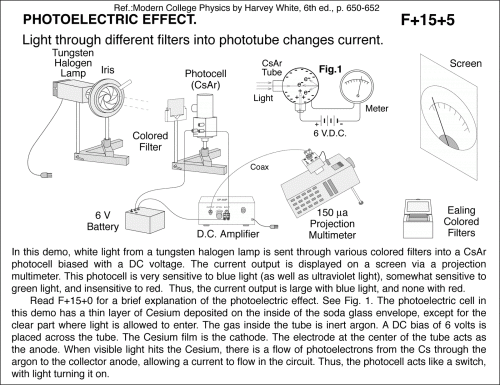Light through different filters into phototube changes current.
Primary tabs
Light through different filters into phototube changes current. In this demo, white light from a tungsten halogen lamp is sent through various colored filters into a CsAr photocell biased with a DC voltage. The current output is displayed on a screen via a projection multimeter. This photocell is very sensitive to blue light (as well as ultraviolet light), somewhat sensitive to green light, and insensitive to red. Thus, the current output is large with blue light, and none with red. Read XX for a brief explanation of the photoelectric effect. See Fig. 1. The photoelectric cell in this demo has a thin layer of Cesium deposited on the inside of the soda glass envelope, except for the clear part where light is allowed to enter. The gas inside the tube is inert argon. A DC bias of 6 volts is placed across the tube. The Cesium film is the cathode. The electrode at the center of the tube acts as the anode. When visible light hits the Cesium, there is a flow of photoelectrons from the Cs through the argon to the collector anode, allowing a current to flow in the circuit. Thus, the photocell acts like a , with light turning it on. Ref.:Modern College Physics by Harvey White, 6th ed., p. 650-652
UCB Index:
F+15+5
PIRA Index:
7A10.35
UCB Taxonomy:
PIRA Taxonomy:
Video:
Popularity:
- Log in to post comments


Comments
Ruza Markov
Wed, 10/23/2013 - 17:03
Permalink
It would be nice to
Mr. Little
Mon, 04/14/2014 - 09:49
Permalink
I agree, and you've got me